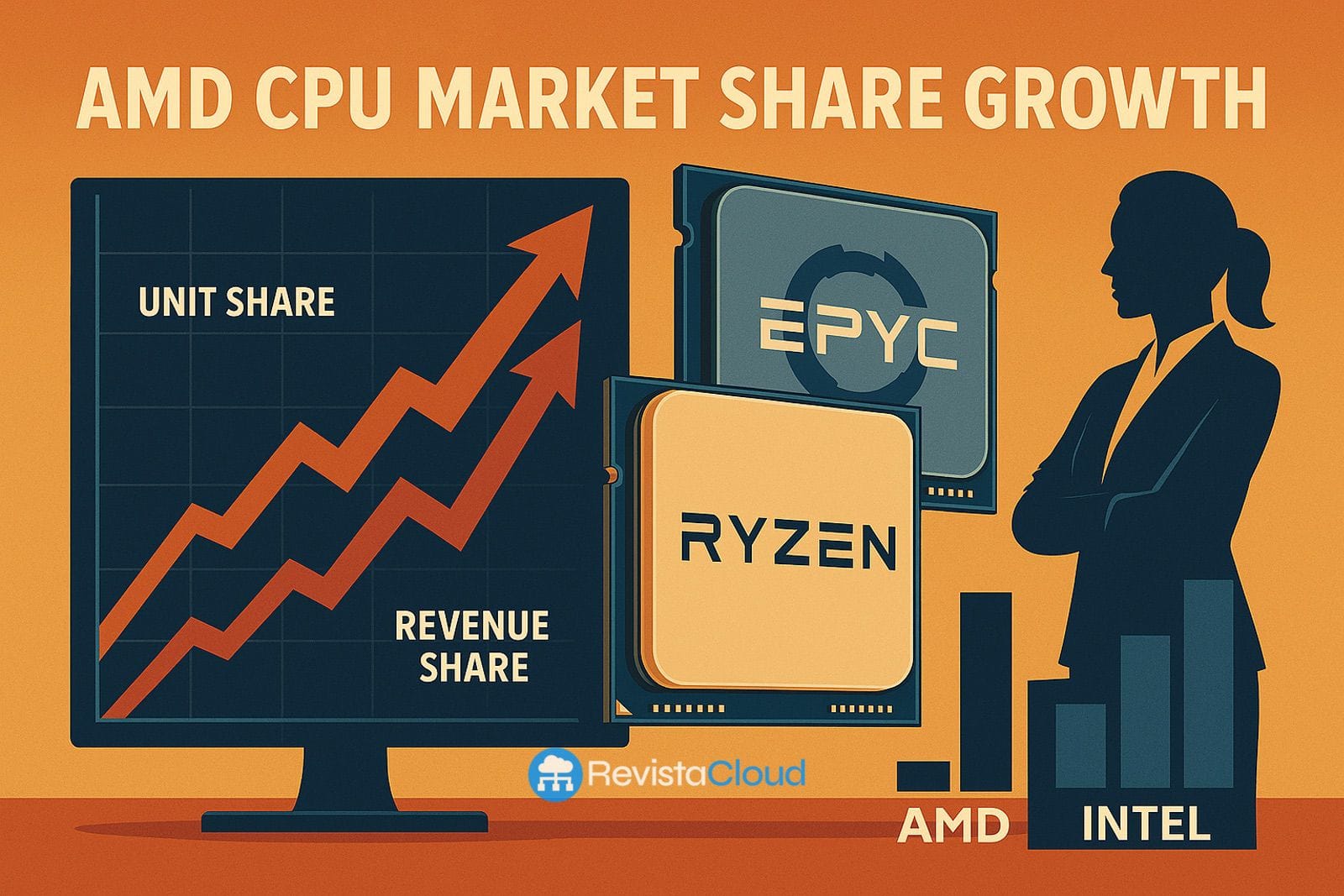Lisa Su’s company leads in profitability and performance with EPYC in servers and Ryzen in desktops, while aiming for more with its AI chips in laptops.
The latest data released by Mercury Research for the first quarter of 2025 confirms what many analysts have been anticipating: AMD is not only gaining ground against Intel but is doing so in the most profitable segments of the processor market. Although the volume of units sold remains relatively stable, the increase in revenue reflects a successful strategy of moving toward higher-value products.
AMD Continues to Gain: More Revenue, Less Dependence on Volume
According to the data, AMD reached a global CPU market share of 24.4% in units and an impressive 31.6% in revenue, improving by 3.6 and 9 percentage points respectively compared to the same period in 2024. This shows that, while it has not yet surpassed Intel in the number of chips sold, it does lead in profitability, thanks to its positioning in the mid-high range and professional environments.
The increase in average selling price (ASP) across all key segments suggests that AMD is selling more high-end chips and that the market is willing to pay more for their performance, efficiency, and capabilities, especially in demanding workloads like AI or cloud servers.
Servers: The Major Growth Engine
The EPYC range from AMD, based on Zen 4 and Zen 5 architecture, is dominating the enterprise sector. AMD has achieved a 27.2% share in units and a 39.4% share in revenue in the server segment. This represents a year-over-year improvement of +3.6 and +6.5 points respectively, and also growth compared to the previous quarter.
Its success in data centers and cloud solutions establishes AMD as a strong alternative to Intel Xeon, which continues to lose presence, particularly among clients who prioritize performance per watt and scalability. This sector, with higher margins, has been key to AMD’s overall revenue growth.
Desktops: Ryzen Gains Traction with the 7000 and 9000 Series
The desktop segment also reflects a notable advance. AMD holds a 28% share in units and 34.4% in revenue, driven by the positive reception of the Ryzen 7000 and 9000 processors.
Growth in value stands out: +15.2 percentage points year-over-year in revenue versus +4.1 points in volume. This difference reinforces the idea that AMD has managed to reposition its brand toward a premium range, even in a market traditionally dominated by Intel.
Laptops: Only Weak Point, but with Positive Nuances
The only significant setback is found in laptops, where AMD records a slight quarterly drop of 1.2% in unit share, standing at 22.5%. However, revenue is increasing, and year-over-year the company adds +3.2 points in units and +7.3 in revenue.
This behavior indicates that, although Intel Lunar Lake continues to dominate the entry-level laptop segment, AMD is gaining ground in more advanced models, thanks to its Ryzen AI APUs with Strix Point and Strix Halo, optimized for artificial intelligence.
AMD’s Premium Focus: Fewer Units, More Revenue
By combining desktops and laptops, AMD achieves a 24.1% share in units and a 26.5% share in revenue. But it is when considering the total CPU (including servers) that the strategy makes full sense: selling less, but better.
The data confirms that AMD is concentrating its efforts on high-margin segments, especially with Zen 5, which is outpacing Intel’s chips in efficiency and power on nearly all fronts.
Where is AMD Headed?
AMD’s strategy is clear: prioritize performance, energy efficiency, and leadership in AI, gaining the trust of consumers, businesses, and cloud providers.
With the success of the EPYC and Ryzen platforms, and an offensive in the field of artificial intelligence and PC Copilot+, AMD seems to have definitively left behind its image as a “budget alternative” to become a major player in the industry. Its CEO, Lisa Su, summarizes it clearly: “High performance everywhere.”
Q1 2025 Market Share Summary (according to Mercury Research):
| Segment | Unit Share | Revenue Share |
|---|---|---|
| Servers | 27.2% | 39.4% |
| Desktops | 28.0% | 34.4% |
| Laptops | 22.5% | (↑) |
| Total Client | 24.1% | 26.5% |
| Global CPU | 24.4% | 31.6% |
AMD is proving that it doesn’t need to sell more to earn more. Its focus on high-performance chips aimed at the professional and advanced gaming markets is paying off. While Intel defends itself, Lisa Su’s company continues to gain revenue, market share, and, above all, brand recognition.
The future of the CPU market is being written in Zen.

